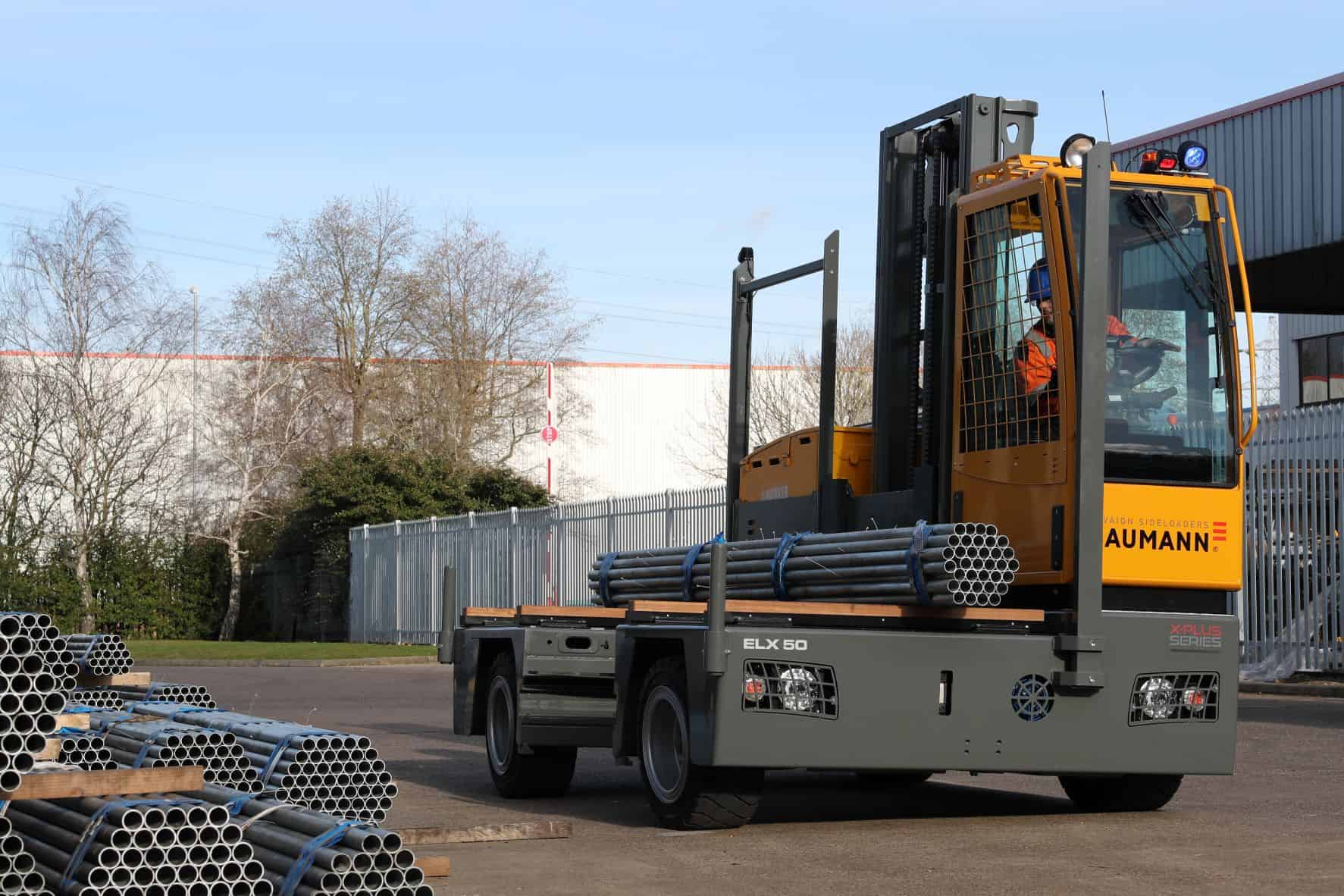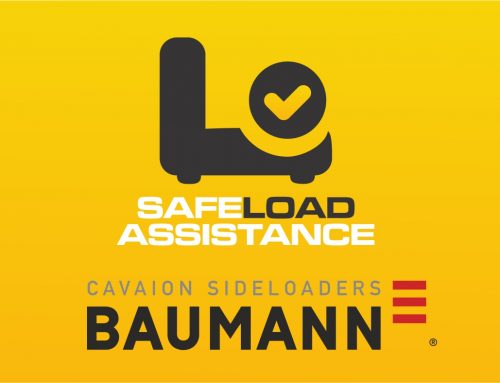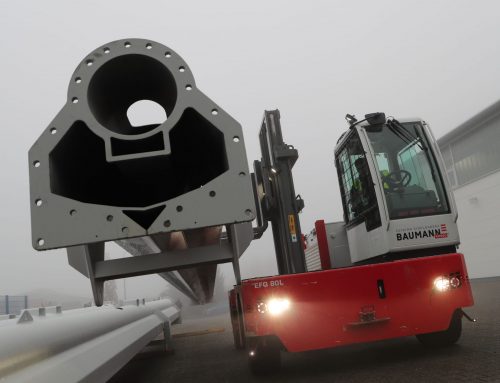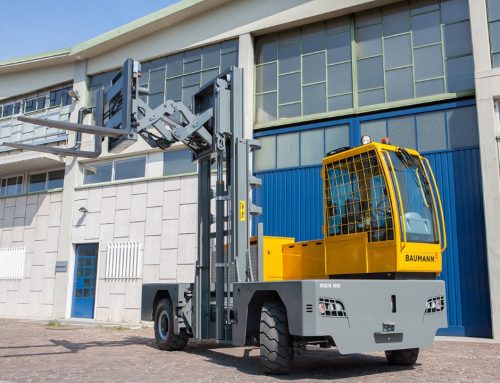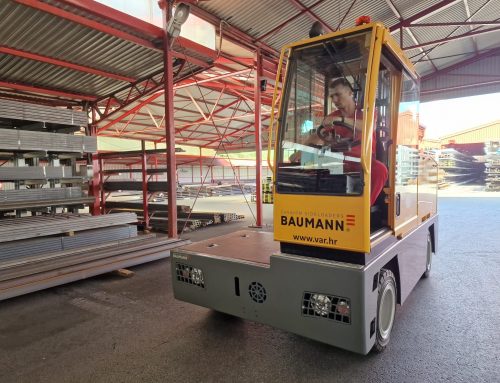At its heart, the best sideloader for the steel industry is one that can handle the weight, is robust and durable, has a simple construction and is easy to service, yet is compact for greater manoeuvrability.
Let’s have a look at some things you need to consider when choosing a sideloader for the steel industry.
Safety
Steel is one of the biggest markets for medium and large capacity Baumann sideloaders.
Beams, sheets, plates, tubes, re-bar, even coils, are the types of heavy loads that require careful handling.
To do so with a forklift can be difficult and dangerous. Travelling with long loads up high is never a good idea at any time, but with a heavy metal load, it can be fatal.
Safety is a big factor in such industries, so the best equipment has features to protect both operator and onlooker, as well as protect the surroundings and the equipment itself from damage.
Individual items can be very heavy – a pack or two of timber could weight just as much as a steel load, but at least the weight is spread over a wider area. A single bar of steel could weigh five tonnes and, if dropped, could cause a lot of damage.
Often you will hear users talk about the heavy demands of such loads on equipment, in particular the weight, extreme heat (a potential source of damage to electrical and hydraulic systems) and ‘metal on metal’.
With high capacities the norm, the equipment is typically larger and this also makes them particularly dangerous for pedestrians.
How Do Baumann Sideloaders Benefit Safety In The Steel Industry?
Some features – camera systems with pedestrian recognition alerts, red zonal lights, blue safety LED lights, audible alarms and on-board operator monitoring systems – are becoming increasingly popular on Baumann sideloaders. They are effective, yet fairly passive, alerting the manager, operator or pedestrian to imminent dangers.
Other operator-assistance features gently nudge behaviour, such as the built-in creep speed when the forks are positioned outside the boundary of the chassis, or the driver door interlock, which ensures the truck will only operate with the door closed.
Safely handling large, heavy loads is generally a key strength of the Baumann GS range.
The higher capacities are complemented by ‘over-dimensioned’ parts (the chassis, axles and mast of the Baumann GS 150-180 series are tested to a safe working load of 20 tonnes) and additional strengthening in key areas.
Protection from falling loads can be found in load posts and grills to the side and cabin roof, whilst heat insulation, in the form of metal plates to the wheels and deck, are useful for protecting operations handling hot aluminium or steel billets.
Sideloaders Accounting For Heat
Another element to consider when choosing a sideloader for the steel industry is heat.
Where heat is a concern, the on-board electronics of our sideloaders are kept to a minimum to reduce the possibility of electromagnetic interference and damage from high temperatures prevalent in steel and aluminium manufacturing.
Many components, such as levers, parking brake and oil supply, are either hydraulic or mechanical.
This also means that sensitive electronic components, such as CAN Bus systems or electronic sensors for wheel hub motors, are not needed.
To make the equipment even more robust, a duplex mast without free lift is incorporated as standard on Baumann GS models.
The GS chassis features redistributed weight to eliminate the need for stabilizers and large axle and wheel dimensions to provide greater torque and load security on uneven ground. The engine is positioned beneath the platform to improve the driver’s visibility and the chassis-tilting system, as a whole, provides greater load security and ease of use.
The Perfect Sideloaders For Lighter Metal Loads
Some metals customers with less heavy loads, perhaps 5 to 8 tonnes in capacity, benefit from the Baumann GX and EGX ranges. These are built on a smaller chassis but have high-quality drive motors and often, for steelworks and steel stockholders, are re-inforced with steel checkerboard plate decks.
Having seen customers use timber bearers on the deck to reduce damage, the option to include a built-in hardwood timber bearer holder was added. Metal or wooden bearers may also be grooved to fix steel tubes or rods in place.
Other Sideloader Features For The Steelwork Industry
Load retaining pins are another safety and productivity feature. Unlike load posts, which protect the operator and key truck components from accidental damage, load pins sit on the corners of the deck to straighten or keep the load from rolling off.
Tapered forks, where the tip of the fork is thinner, help those that have small gaps between sheets or other loads to contend with, whilst solid tyres and foam filled tyres can mitigate the difficulties of those plagued by punctures.
Options such as convenient hydraulic stairs or central lubrication systems further increase the service-friendliness, ease of use, performance and safety of these huge, heavy-duty sideloaders.
Ready To Talk?
We have been manufacturing and supplying sideloaders to the steel industry for over half a century. We understand our side, and we listen to you to learn from your side.
That means you get a product that is perfect for your needs, to help your business grow and to protect your team.
Get in touch with us to see how we can help. Email info@baumann-sideloaders.co.uk or contact us here.

